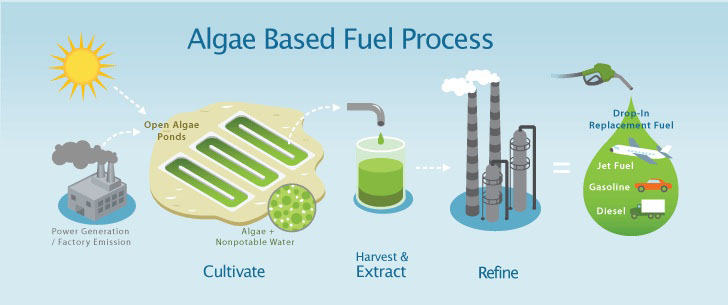Just last month, Green Crude Farms became fully operational. This is the first phase of Sapphire Energy’s algae based green-crude oil production facility, and as the first commercial demonstration algae-to-energy facility, it marks an important moment for Sapphire Energy and the algae biofuel industry as a whole.
Set in the desert outside of Columbus, New Mexico, the project is a public-private partnership. According to their website:
>“Led by $85 million in private investment, Sapphire was awarded a $50 million grant from the Department of Energy and a $54.4 million dollar loan guarantee from the Department of Agriculture, providing security for a privately funded loan. These awards exemplify the value the United States sees in weaning dependency off petroleum and transitioning to a purposeful and domestic form of new energy.”
This first phase of construction began in June 2011, and so far the project has been on time and within budget. Once the facility is complete, it will be capable of producing approximately 1.5 million gallons a year of crude oil and will cover some 300 acres with algae ponds and processing facilities.
There are high hopes for algae biofuels. Algae is fast growing and does not compete with existing food sources in the way that corn ethanol does. But algae biofuels for transportation have in the past been hampered by a high carbon footprint and a lack of available technology to turn the algae into liquid fuel. Some of the limitations of the ‘second generation’ biofuels were addressed in our previous post on The Future of Biofuels.
In 2010, a paper was released by the Journal of Environmental Science & Technology which examined the life cycle of algae and other biofuels. The conclusions of the two year study showed that other biostocks like switchgrass, canola and corn had a lower environmental impact than algae, making algae appear much less viable as an alternative fuel.
The main reason for this is the fact that algae needs CO2 to grow. The source of that CO2 is very important to the overall impact of growing algae. If the CO2 must be created to ‘feed’ the algae, then it is no longer a very clean fuel. On the other hand, the study showed, if the CO2 can be harvested as a by-product of waste water, the environmental footprint changes dramatically.
But Sapphire Energy has taken a totally new and unique approach. Rather than making an ethanol or diesel fuel, they are actually making ‘Green Crude’. The Algal Biomass Organization, an industry research and education group, explains it this way:
>“San Diego-based Sapphire Energy is pioneering an entirely new industry – Green Crude – production with the potential to profoundly change America’s energy and petrochemical landscape for the better. Sapphire’s products and processes in this category differ significantly from other forms of biofuel because they are made solely from photosynthetic microorganisms (algae and cyanobacteria), using sunlight and CO2 as their feedstock; are not dependent on food crops or valuable farmland; do not use potable water; do not result in biodiesel or ethanol; enhance and replace petroleum-based products; are compatible with existing infrastructure; and are low carbon, renewable and scalable.”
Sapphire Energy hopes to lead the way for the algae biofuel revolution by making Green Crude a viable alternative to foreign crude oil imports. Alternatives to imported oil are increasingly crucial, with evidence showing that global crude production has been flat for seven years, and demand for crude oil has risen in places like Saudi Arabia. Green Crude also emits 60-70% less greenhouse gases than regular crude oil when burned.
The algae ponds at Green Crude Farm were seeded back in March of this year and so far the results have exceeded expectations. According to the Sacramento Bee, the first harvest of approximately 80 million tons of algae occurred in June. If all goes as planned, they will be able to produce 100 barrels of green crude per day by 2014.
One of the most important pros to ‘green crude’ from algae is the fact that it is a ‘drop in’ fuel for transportation. This means that it can be processed in the same way as crude oil and can seamlessly replace gasoline, jet fuel or diesel in existing vehicles without costly or systemic changes to the engine structure. There is no mixing or blending like with ethanol, it just replaces the crude oil. On the other hand, some experts think that we may soon see the ‘twilight’ of the combustion engine as it is replaced by natural gas fueled electric vehicles.
According to Pike Research and Forbes magazine, algae biofuel has the potential to become a $1.3 billion market by 2020, producing some 61 million barrels a year. To put that in perspective, the United States uses about 18 million barrels of oil a day. So while it may be a while before any algae biofuel replaces oil, ‘green crude’ and other viable forms of algae biofuel have the potential to become a major player in the overall domestic energy portfolio.

